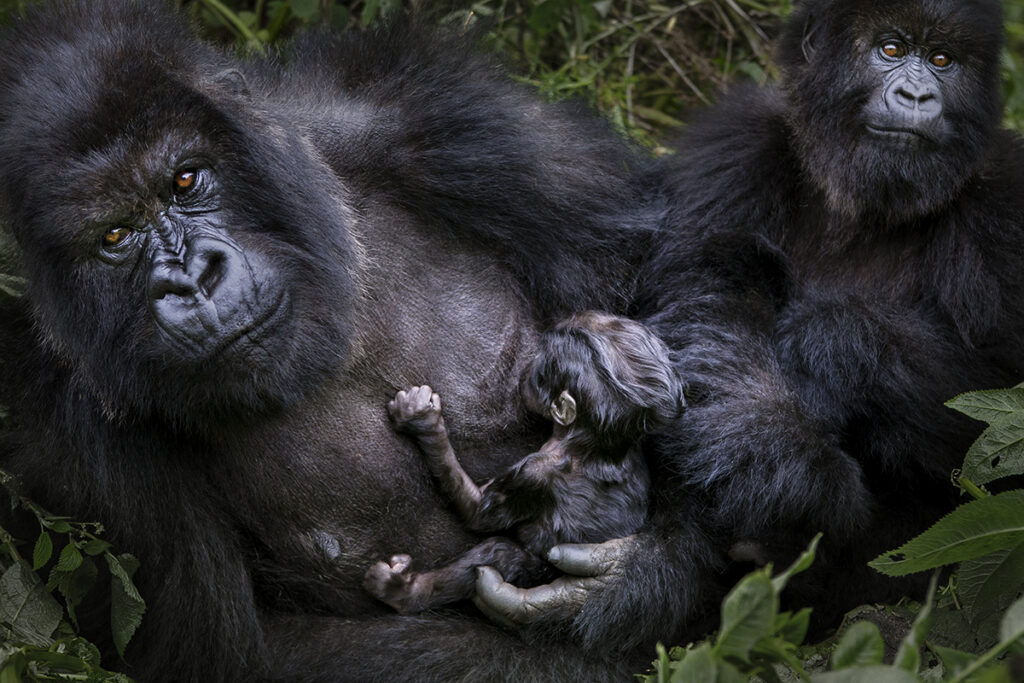Why I Keep Returning to the Highlands of Rwanda and seeking out remote places like Mahale and the Congo
Few creatures on this planet fascinate me more than primates. Maybe it’s their expressiveness, their familial bonds, the way they seem to live so fully in each moment, or because they are so similar to us. Over the years, I’ve spent countless hours quietly observing them in awe and photographing them. These are the moments that stay with me.

Mountain gorillas were the first to take hold of my heart. I’ll never forget my earliest trek in the volcanic highlands of Rwanda. The path wound upward through the forest, the air damp and heavy with anticipation. We moved slowly, weaving through thick stands of bamboo, guided by the quiet signals of our trackers. And then suddenly there they were. A family of giants. A mother cradling her infant, a young male chest-thumping through the ferns, and off to the side, a silverback watching us with a calm authority that made the world go still.

To be eye-to-eye with such a powerful, intelligent being in its natural habitat—untouched, uncontained—is something no words or photographs can fully explain. It feels ancient. It feels right. It humbles you.
I’ve since returned to Rwanda many times. Each trek is different. Each encounter carries a weight that never fades. And while there are other places to see gorillas, few compare to Rwanda—not just because it is less challenging than treks in other countries, but also for its remarkable conservation efforts and the integrity of the experience. It remains deeply respectful, carefully managed, and astonishingly wild.
And then there’s Mahale. If gorilla trekking in Rwanda is a spiritual climb into the mountains, chimp trekking in Mahale is a raw plunge into the jungle.

There are no roads here. You fly to a remote airstrip, take a boat along the shores of Lake Tanganyika, and arrive at a place where the forest runs thick and unbroken all the way to the water’s edge. The chimps here are some of the last truly wild chimpanzees on Earth. You don’t find them by schedule—you find them by sound. Sometimes it takes time wandering through a tangled forest. Sometimes you’re lucky. But always, when the moment comes, it takes your breath away.
To hear a chorus of chimpanzees echoing through the canopy—to see them crash through the trees, form alliances, cradle their young, or launch into displays of power—is to witness something utterly primal. You feel like a guest in a world that was never meant to be yours. And that’s the point.

This place is not easy to reach, and that’s precisely why the experience is so powerful. It hasn’t been overrun, diluted, or commercialized. No roads lead to Mahale. But some of the most meaningful journeys never follow a road at all.
For me, primate trekking has never been just about getting the photograph. It’s about the thrill of the search, the unpredictability of the wild, and the raw, unscripted moments that unfold when you step off the map and into their world.
These experiences can be tough. The terrain is challenging, the weather shifts without warning, and nothing is guaranteed. But that’s what makes it real. That’s what makes it unforgettable.

If you’re drawn to journeys that test you, move you, and leave you changed—trekking through the jungles of Rwanda or Mahale might be precisely what you’ve been looking for.
If you’ve ever dreamed of standing in the mist, face to face with a mountain gorilla— The next chapter begins in the highlands of Rwanda.
>> Explore Rwanda & Uganda Safari
There are no roads to Mahale—just your footsteps and a story waiting to be lived.
>> Explore Secrets of the Serengeti & Chimps
